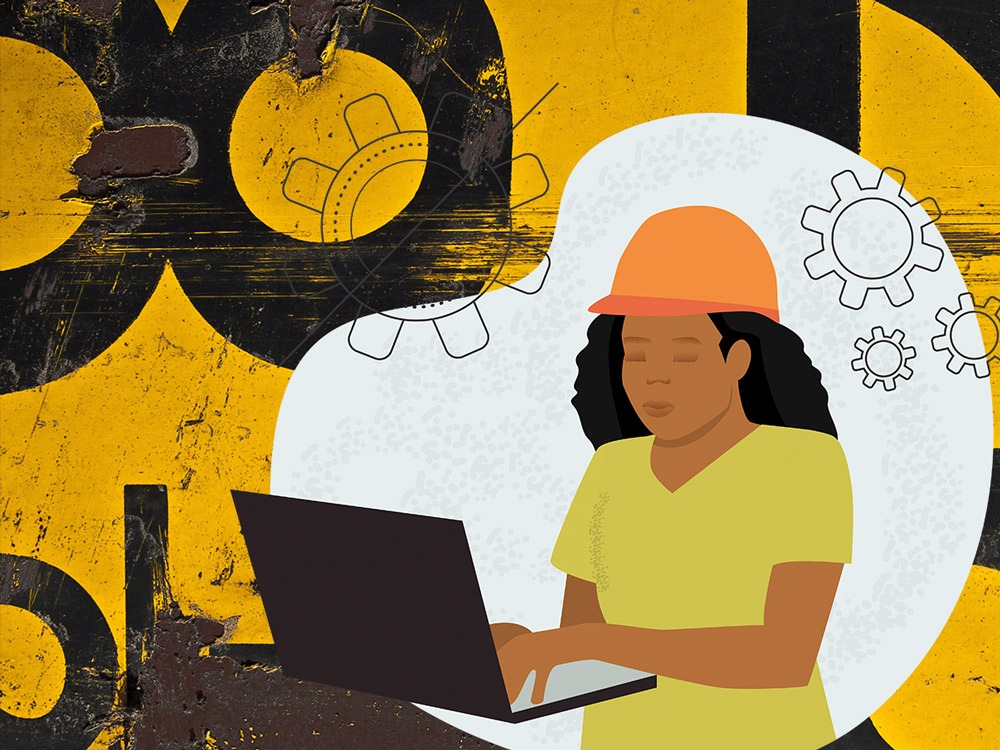[ad_1]

Several recent studies have shown that technology can exacerbate bias and discrimination. For instance, Amazon’s recruiting algorithm discriminated against women applying for technical roles, artificial-intelligence researchers Joy Buolamwini and Timnit Gebru have found significant racial and gender bias in face-recognition technologies, and search engines are also biased, according to Dr. Safiya Umoja Noble’s research on Google’s top results for specific phrases about women and girls of color.
Even as more reports illustrate the harms of biased tech, nonprofit organizations are also strategically using digital technology’s power to fight inequality and racial injustice at scale.
Fast Forward, a tech nonprofit accelerator, highlighted a few such organizations during their Demo Day 2022 event. At in-person sessions in New York City and San Francisco, and virtually on Youtube Live, Demo Day brought together nine social entrepreneurs to explore solutions for problems they’ve experienced.
“Tech nonprofit” is an emerging term that refers to a tech startup that is building software or web applications using a nonprofit model for social impact.
Take, for instance, Unlocked Labs, a nonprofit that employs a team of incarcerated software developers who are building nonprofit, open-source technology to make high-quality education more accessible to incarcerated individuals. “Education has been proven to be one of the most effective interventions in reducing recidivism, but access to quality opportunities is very limited,” Unlocked Labs’ founders Haley Shoaf and Jessica Hicklin say.
Research backs up their claim: Studies show that incarcerated individuals who participate in prison education programs are 43 percent less likely to return to prison than those who did not enroll; yet, only a quarter of people in prison participate in vocational training programs.
Individuals impacted by the criminal legal system also benefit from access to educational programs that prepare them for workforce re-entry while qualifying them for well-paying jobs. A Vera Institute of Justice report shows that incarcerated people who pursue a postsecondary degree or take adult basic education courses in prison get better pay and experience an almost 50% decrease in recidivism. But such educational opportunities are “often highly selective, and many barriers exist for students of color to both prepare for and access these programs,” the founders add.
Organizations like Unlocked Labs are stepping in to reduce these barriers and offer equal access to education so that incarcerated individuals—and, in particular, people of color, who are overrepresented among America’s prison population—feel job-ready when they’re released. People of color already face several levels of discrimination during the hiring process and at work; having a criminal record compounds this discrimination. Unlocked Labs aims to reduce the disparity caused by such discrimination by empowering incarcerated people of color with a high-quality education to help them take up better jobs, improving their post-release prospects.
Along with educational opportunities, the nonprofit organization provides incarcerated individuals with a “record of their achievements that they can utilize in parole hearings or post-release to validate their skills and experience on the inside and provide steppingstones to a better life after incarceration,” Shoaf and Hicklin say.
This level of skills and portfolio development would not have been possible without digital technology. “Most prisons are rurally located, limiting the opportunities for in-person instruction,” the founders say. “Technology allows us to reduce this barrier by providing educational access in the correctional space.”
Using Tech to Reduce Barriers to Education
Unlocked Labs is one of a number of nonprofits using tech to create opportunities for people from marginalized communities. Two other organizations making education more accessible to traditionally excluded populations are Black Sisters in STEM (Black SiS) and Empowr. Both nonprofits are using tech to help students of color gain access to educational resources, readying them for high-paying careers.
“Nearly 50% of Black students don’t have access to STEM classes that will get them college-ready,” says Adrian Le’Roy Devezin, Executive Director of Empowr. Moreover, says Diana Wilson, CEO and founder of Black SiS. “Black women struggle at every stage of the STEM pipeline,” she says. “Yet research has shown it’s not due to a lack of desire, or capacity, but a lack of support throughout the development pipeline.”
The two organizations are using technology to bridge this racial divide. Empowr creates a school-to-career pipeline for students of color by offering a learning platform that teaches software development to Black high school students. Along with teaching technical skills, the organization provides students with job preparation and helps them find placements, striving to “ensure every student has a six-figure career waiting,” Devezin says. The organization aims to end poverty cycles directly out of high school. “Since we do it through a quality STEM education, we are also reducing the education disparity that puts Black children at a disadvantage,” Devezin adds.
Similarly, Black SiS guides Black women in postsecondary education through select learning pathways in STEM careers. “We help them build a digital portfolio that showcases their practical skills in tech through hands-on projects,” Wilson says. “We build networks, connecting our users with one another and mentors to accelerate their success and use intelligent matching to curate career opportunities for our fellows in partnership with tech companies.” The organization also offers culturally relevant content designed to support Black women as they navigate white-dominated STEM workplaces, including articles on job interview strategies. Such content works as a guidebook to help Black women navigate racial disparities in predominantly white organizations. It also gives them concrete tips they can use everyday when facing difficult situations at work. Today, Black SiS is helping over 4,000 women across 12 countries.
Empowr and Black SiS hope to effectively leverage technology to reduce barriers to education and career opportunities for people of color. Empowr’s entire model is tech-based, and the organization frequently uses third-party software like CoScreen to make learning easier, entertaining, and more efficient. “The reality is students learn better when they can learn together,” Devezin says. “With CoScreen they can remote into each other’s computers and access the integrated development environment (IDE), which enables them to write code and solve challenges as a team.”
Sign up for our free newsletter
Subscribe to the NPQ newsletter to have our top stories delivered directly to your inbox.
By signing up, you agree to our privacy policy and terms of use, and to receive messages from NPQ and our partners.
In contrast, Black SiS started out as an in-person training program with 10 young women, but the community quickly grew to thousands of users, who “complained of having theoretical knowledge but little to no avenues to build practical skills,” Wilson says. “Companies were requesting their portfolios and they had nothing to show forth in a shareable, live, and public way.” Moreover, the global nature of Black SiS’ operations meant time zones became an issue. “Many of our users in emerging markets such as Nigeria have access to the internet sporadically,” Wilson says.
To accommodate these needs and serve a community of millions of Black sisters in STEM, the nonprofit pivoted to a tech-first model, meaning the organization uses digital technology as its primary resource. This eliminates or at least reduces geographical barriers to access; not every user can travel to in-person trainings, but most users can access an online class if provided the right tools. “Our tech allows us to organize the largest library for Black women in STEM careers, and our smart recommendation system allows our fellows to receive hyper-targeted, tailored learning resources to improve their skills,” Wilson says. “Our learning development platform is structured around real-world projects, which allows our students to build a public digital portfolio of work and showcase their demonstrated ability,” she adds.
Helping Immigrant Communities of Color
From escaping violent conflicts to reuniting with family, there are various reasons why people emigrate. Today, nearly one in eight people living in the US can be considered immigrants, but the nation isn’t an immigrant friendly one. Recent surveys show that nine percent of Americans want to completely shut down US borders to keep out immigrants, and only one-third of citizens are open to removing current immigration restrictions. Even when people manage to immigrate to the US, many face new difficulties. They include people of color who already face discrimination and find it increasingly challenging to secure safe asylum in a new state.
That’s where the Asylum Seeker Advocacy Project (ASAP) comes in. The nonprofit helps asylum seekers navigate the complex US immigration system by providing in-depth legal resources, breaking immigration news alerts, and a virtual legal help desk where members can ask immigration attorneys questions about their cases.
Take, for example, Wendi, a single mother seeking asylum from Guatemala. Wendy was part of a federal lawsuit that ASAP filed on behalf of members in an attempt to stop Trump’s anti-immigration policies from going into effect. She “worked with ASAP attorneys to tell her story to the court and explain how these new restrictions left her without a path to safety and stability,” her member spotlight post reads. With ASAP’s legal assistance, she was able to secure a work permit, a social security number, and a decent job to support herself and her kids.
In this manner, ASAP is said to have helped over 150,000 members secure a work permit, allowing them to enter the legal workforce and potentially unlocking $1.5 billion in additional household income.
ASAP attributes its success to its use of digital technology. “Technology was the only way we could go from 5,000 total members to onboarding approximately 4,000 members a week,” says Swapna Reddy, co-executive director of ASAP. “Technology is the only way we can communicate rapidly, en masse, to asylum seekers from more than 175 countries now spread across all US states and territories.” The organization also connects asylum seekers with each other to create a supportive network via SMS, email, and WhatsApp. “We connect with members through the mediums they trust—the mediums they use to communicate with their families in the United States and abroad.”
Educational Technology: A Key Tool for Racial Equity?
All these nonprofits have one thing in common. They’re minimizing or removing barriers to education and information so that marginalized people can build better futures for themselves and their communities.
While education cannot eliminate discrimination on its own, several studies have shown it goes a long way toward reducing disparities and enabling diverse communities to find stability and security. That’s why, from educating incarcerated people to reduce recidivism to helping asylum seekers gain work permits, these nonprofits hope to leverage technology to bring learning and work opportunities to people who are most negatively impacted by systemic oppression.
Tech Is No Substitute for Human Support
Hundreds and thousands of organizations are leveraging technology to improve lives. But while tech is helpful, it can sometimes exacerbate the problems it’s trying to solve. “Often the barrier to racial justice and equality is the technological divide,” Shoaf and Hicklin say. For example, “disadvantaged populations, like justice-involved individuals, are prevented from accessing technology resources due to either tangible or intangible barriers—that is, prison restrictions in the case of justice-involved individuals or financial burdens limiting hardware and internet resources.”
Moreover, while tech makes it easier for nonprofits to connect people of color around resources and opportunities—students with teachers, graduates with employers, and immigrants with lawyers—it’s nowhere near replacing the human element. No matter how advanced, the programs require human understanding and assistance, albeit through a digital medium, and would fall apart without it. “Tech can be a force for good in the world, but it is important for nonprofits to be realistic about what technology can actually replace,” Reddy says. “Technology should be used for scaling, automation, and logistics, not to replace human-to-human interactions.”
Is this a direct quote or a paraphrase? I see a closing quotation mark but not an opening one. If this isn’t a direct quote, the percentage alone is fine and you can delete “almost half” and the parentheses around “40%”
[ad_2]
Source link



